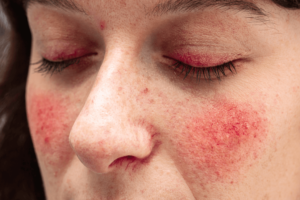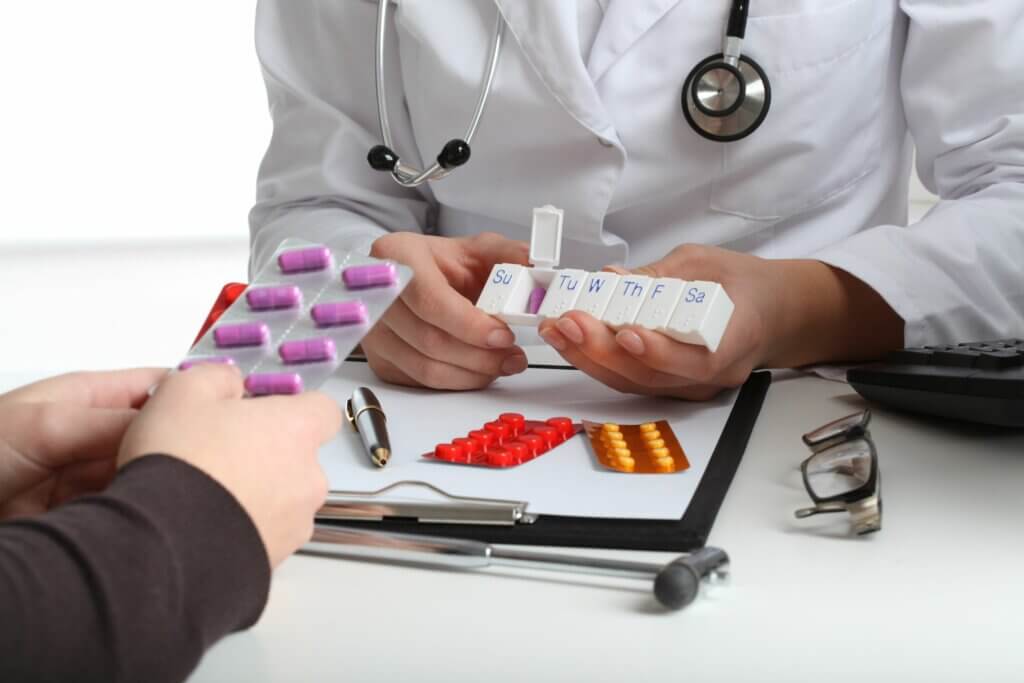Rosacea: Everything You Need to Know

Rosacea is a chronic skin disorder. It’s characterized by permanent redness on the face, although it can also affect the scalp and the eye area. It’s usually common in people with fair complexions, who also have fine and sensitive skin.
Unlike acne vulgaris, which can occur from an early age, rosacea usually affects people over 30 years of age and doesn’t cause comedones (blackheads or whiteheads). However, there may be papules and pustules.
Since information plays a key role in its prevention, we’re going to tell you everything you need to know about this dermatological disorder.
Rosacea symptoms
The most prominent symptom of rosacea is chronic redness of the skin in areas such as the cheeks, forehead, and nose. At first, it’s usually transitory, which is why it’s sometimes called flushing.
As the redness becomes more persistent, other symptoms appear:
- Visible vascular dilatations (telangiectasias)
- Red pimples without pus (papules)
- Red pimples with pus (pustules)
- Changes in the texture of the skin
- Thickening of the skin and the appearance of lumps in the nose area (rhinophyma)
Rosacea can also cause other discomfort in affected areas, such as burning, irritation, itching, and discomfort. Although not in all cases, it can also affect the eyes. When this is the case, it causes redness, itching, a burning sensation, tearing, photosensitivity, and even inflammation of the eyelids.

Causes
Although the cause of rosacea is unknown, there are some factors that can give us an idea of why it occurs. Some of the most prominent are the following:
- Predisposition to vascular hyperresponsiveness. This means that the blood vessels of the face dilate more easily under certain stimuli and cause facial redness.
- Microcirculation problems that affect the blood vessels of the face.
The MSD Manual points to the presence of follicle mites (Demodex folliculorum as a concomitant situation. Increased angiogenesis, ferritin expression, and reactive oxygen species have also been hypothesized, as well as dysfunction of antimicrobial peptides (such as cathelicidin).
Triggers
As scientific evidence points out, rosacea seems to get worse under certain stimuli:
- Cold and heat
- Constant wind
- Sun exposure
- Very hot showers or baths
- Emotional stress and intense emotions
- Consumption of soy sauce
- Very hot, spicy food and drinks
- Consumption of alcohol or tobacco
- Long-term use of topical corticosteroids
- The use of cosmetic products that contain alcohol, acetone or retinoids
Diagnosis of rosacea
At the moment, there’s no test to help diagnose rosacea. However, the clinical evaluation is usually sufficient, as well as the differential diagnosis.
The latter takes into account acne vulgaris, dermatitis, photodermatitis, cutaneous granulomas, drug rashes (especially those caused by iodides and bromides), sarcoidosis, systemic lupus erythematosus, and other skin disorders. Biopsies aren’t usually requested for the diagnosis of rosacea.
Treatment for rosacea
There’s no curative treatment for rosacea, but there is a method that allows you to control the signs and symptoms. This includes avoiding the triggers we’ve mentioned. If appropriate, the doctor will refer to an ophthalmologist to monitor the symptoms of ocular rosacea.
General measures
- Apply sunscreen daily
- Protect the skin from adverse climatic factors: wind, cold, heat
- Don’t rub, scratch, or handle the affected area
- Use products suitable for your type of skin.
Medicines
Depending on the severity of the symptoms, the treatment will vary. For example, in mild cases, topical creams are often prescribed to control redness.
Some of the most common options are brimonidine and oxymetazoline, as well as drugs that contain azelaic acid and metronidazole. In cases where rosacea is moderate or severe, your doctor may prescribe oral antibiotics, such as doxycycline. In severe cases, the doctor may prescribe isotretinoin.

Laser treatment
Laser therapy and other light-based therapies can reduce symptoms. Above all, the redness. Several sessions are scheduled and, as the skin responds, the doctor will decide whether to space them out or maintain the same frequency.
Living with rosacea
Living with rosacea can be distressing and complicated, given the aesthetic and emotional impact the disease has. Therefore, the support of a psychologist is necessary to manage negative emotions, feelings, and thoughts.
In addition to counseling, you can turn to support groups and online and face-to-face communities.
Ultimately, avoiding triggers, following your doctor’s guidelines, and maintaining a healthy lifestyle will go a long way towards helping you. Don’t forget that, even though the treatment can be very useful, you shouldn’t neglect the periodic check-ups. These allow the doctor to monitor the evolution and effectiveness of the treatment.
Rosacea is a chronic skin disorder. It’s characterized by permanent redness on the face, although it can also affect the scalp and the eye area. It’s usually common in people with fair complexions, who also have fine and sensitive skin.
Unlike acne vulgaris, which can occur from an early age, rosacea usually affects people over 30 years of age and doesn’t cause comedones (blackheads or whiteheads). However, there may be papules and pustules.
Since information plays a key role in its prevention, we’re going to tell you everything you need to know about this dermatological disorder.
Rosacea symptoms
The most prominent symptom of rosacea is chronic redness of the skin in areas such as the cheeks, forehead, and nose. At first, it’s usually transitory, which is why it’s sometimes called flushing.
As the redness becomes more persistent, other symptoms appear:
- Visible vascular dilatations (telangiectasias)
- Red pimples without pus (papules)
- Red pimples with pus (pustules)
- Changes in the texture of the skin
- Thickening of the skin and the appearance of lumps in the nose area (rhinophyma)
Rosacea can also cause other discomfort in affected areas, such as burning, irritation, itching, and discomfort. Although not in all cases, it can also affect the eyes. When this is the case, it causes redness, itching, a burning sensation, tearing, photosensitivity, and even inflammation of the eyelids.

Causes
Although the cause of rosacea is unknown, there are some factors that can give us an idea of why it occurs. Some of the most prominent are the following:
- Predisposition to vascular hyperresponsiveness. This means that the blood vessels of the face dilate more easily under certain stimuli and cause facial redness.
- Microcirculation problems that affect the blood vessels of the face.
The MSD Manual points to the presence of follicle mites (Demodex folliculorum as a concomitant situation. Increased angiogenesis, ferritin expression, and reactive oxygen species have also been hypothesized, as well as dysfunction of antimicrobial peptides (such as cathelicidin).
Triggers
As scientific evidence points out, rosacea seems to get worse under certain stimuli:
- Cold and heat
- Constant wind
- Sun exposure
- Very hot showers or baths
- Emotional stress and intense emotions
- Consumption of soy sauce
- Very hot, spicy food and drinks
- Consumption of alcohol or tobacco
- Long-term use of topical corticosteroids
- The use of cosmetic products that contain alcohol, acetone or retinoids
Diagnosis of rosacea
At the moment, there’s no test to help diagnose rosacea. However, the clinical evaluation is usually sufficient, as well as the differential diagnosis.
The latter takes into account acne vulgaris, dermatitis, photodermatitis, cutaneous granulomas, drug rashes (especially those caused by iodides and bromides), sarcoidosis, systemic lupus erythematosus, and other skin disorders. Biopsies aren’t usually requested for the diagnosis of rosacea.
Treatment for rosacea
There’s no curative treatment for rosacea, but there is a method that allows you to control the signs and symptoms. This includes avoiding the triggers we’ve mentioned. If appropriate, the doctor will refer to an ophthalmologist to monitor the symptoms of ocular rosacea.
General measures
- Apply sunscreen daily
- Protect the skin from adverse climatic factors: wind, cold, heat
- Don’t rub, scratch, or handle the affected area
- Use products suitable for your type of skin.
Medicines
Depending on the severity of the symptoms, the treatment will vary. For example, in mild cases, topical creams are often prescribed to control redness.
Some of the most common options are brimonidine and oxymetazoline, as well as drugs that contain azelaic acid and metronidazole. In cases where rosacea is moderate or severe, your doctor may prescribe oral antibiotics, such as doxycycline. In severe cases, the doctor may prescribe isotretinoin.

Laser treatment
Laser therapy and other light-based therapies can reduce symptoms. Above all, the redness. Several sessions are scheduled and, as the skin responds, the doctor will decide whether to space them out or maintain the same frequency.
Living with rosacea
Living with rosacea can be distressing and complicated, given the aesthetic and emotional impact the disease has. Therefore, the support of a psychologist is necessary to manage negative emotions, feelings, and thoughts.
In addition to counseling, you can turn to support groups and online and face-to-face communities.
Ultimately, avoiding triggers, following your doctor’s guidelines, and maintaining a healthy lifestyle will go a long way towards helping you. Don’t forget that, even though the treatment can be very useful, you shouldn’t neglect the periodic check-ups. These allow the doctor to monitor the evolution and effectiveness of the treatment.
- Barco D, Alomar A. Rosácea. Actas Dermosifiliogr [Internet]. 2008 May 1 [cited 2021 Jul 10];99(4):244–56. Available from: http://www.actasdermo.org/es-rosacea-articulo-S0001731008746726
- Guías clínicas para el tratamiento de la rosácea | Asocolderma Revista [Internet]. [cited 2021 Jul 10]. Available from: https://revistasocolderma.org/articulo-revista/guias-clinicas-para-el-tratamiento-de-la-rosacea-0
- Keri JE. Rosácea – Trastornos dermatológicos – Manual MSD versión para profesionales [Internet]. [cited 2021 Jul 10]. Available from: https://www.msdmanuals.com/es/professional/trastornos-dermatológicos/acné-y-trastornos-relacionados/rosácea
- Troielli P, Manuel González Otero F, Manuel Ríos Yuil J, Tomás Vázquez Martínez O, Guillermo Pabón Montoya J, Ibarra M, et al. Actualización y recomendaciones para el diagnóstico y tratamiento de la rosácea en Latinoamérica Update and recommendations for the diagnosis and treatment of rosacea in Latin America. Med Cutan Iber Lat Am [Internet]. 2016 [cited 2021 Jul 10];44(S1):7–26. Available from: www.medigraphic.com/medicinacutaneawww.medigraphic.org.mx
Este texto se ofrece únicamente con propósitos informativos y no reemplaza la consulta con un profesional. Ante dudas, consulta a tu especialista.







